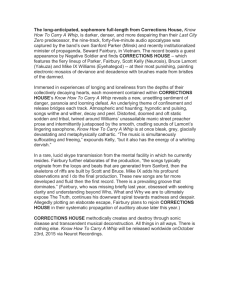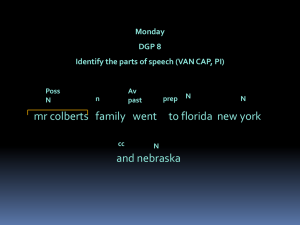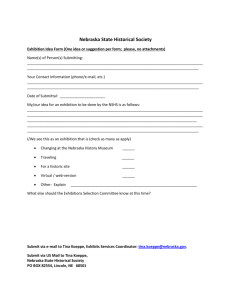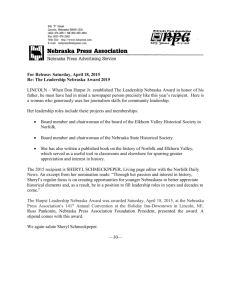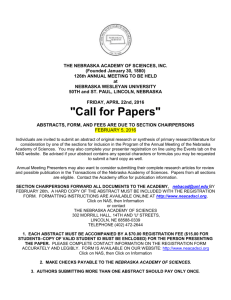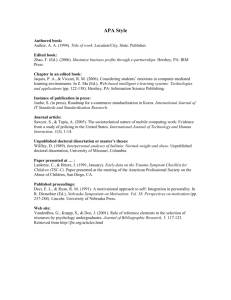Article Title: E J Hested and Nebraska's Home
advertisement
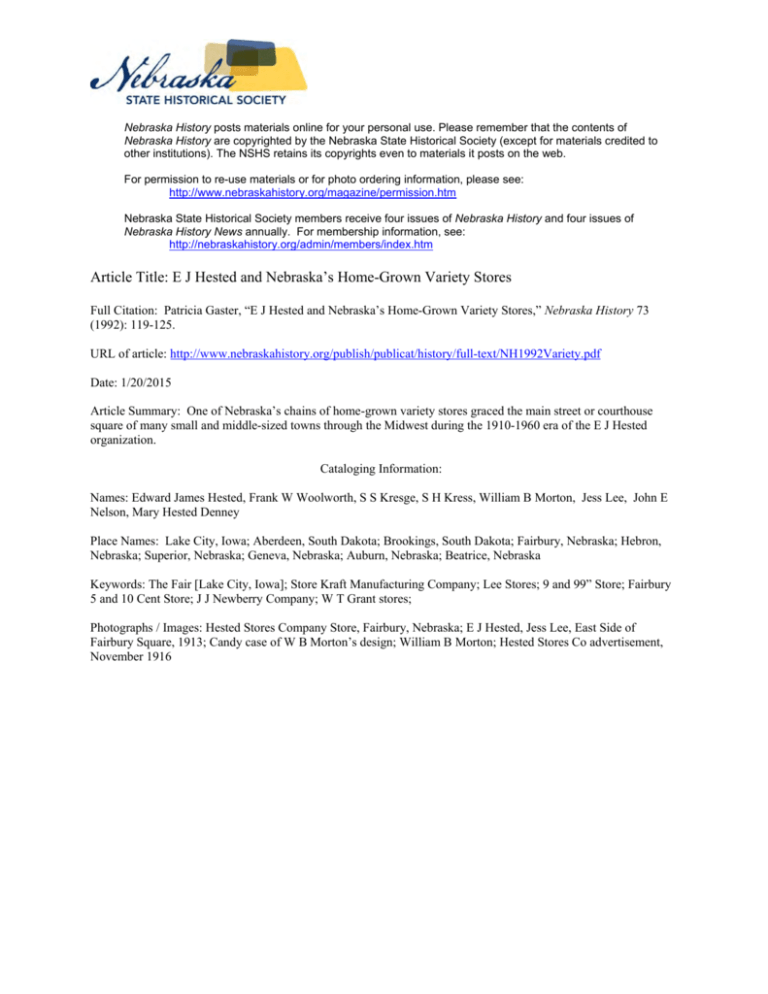
Nebraska History posts materials online for your personal use. Please remember that the contents of
Nebraska History are copyrighted by the Nebraska State Historical Society (except for materials credited to
other institutions). The NSHS retains its copyrights even to materials it posts on the web.
For permission to re-use materials or for photo ordering information, please see:
http://www.nebraskahistory.org/magazine/permission.htm
Nebraska State Historical Society members receive four issues of Nebraska History and four issues of
Nebraska History News annually. For membership information, see:
http://nebraskahistory.org/admin/members/index.htm
Article Title: E J Hested and Nebraska’s Home-Grown Variety Stores
Full Citation: Patricia Gaster, “E J Hested and Nebraska’s Home-Grown Variety Stores,” Nebraska History 73
(1992): 119-125.
URL of article: http://www.nebraskahistory.org/publish/publicat/history/full-text/NH1992Variety.pdf
Date: 1/20/2015
Article Summary: One of Nebraska’s chains of home-grown variety stores graced the main street or courthouse
square of many small and middle-sized towns through the Midwest during the 1910-1960 era of the E J Hested
organization.
Cataloging Information:
Names: Edward James Hested, Frank W Woolworth, S S Kresge, S H Kress, William B Morton, Jess Lee, John E
Nelson, Mary Hested Denney
Place Names: Lake City, Iowa; Aberdeen, South Dakota; Brookings, South Dakota; Fairbury, Nebraska; Hebron,
Nebraska; Superior, Nebraska; Geneva, Nebraska; Auburn, Nebraska; Beatrice, Nebraska
Keywords: The Fair [Lake City, Iowa]; Store Kraft Manufacturing Company; Lee Stores; 9 and 99” Store; Fairbury
5 and 10 Cent Store; J J Newberry Company; W T Grant stores;
Photographs / Images: Hested Stores Company Store, Fairbury, Nebraska; E J Hested, Jess Lee, East Side of
Fairbury Square, 1913; Candy case of W B Morton’s design; William B Morton; Hested Stores Co advertisement,
November 1916
E. J. HESTED AND NEBRASKA'S HOME-GROWN VARIETY STORES By Patricia Gaster
The variety or five-and-ten-cent
store is firmly embedded in American
business and social history. Browsing
in the neighborhood or small town five­
and-dime was not so much "shopping"
as "adventuring" - what has more
recently been called a "shopping
experience." One of Nebraska's chain
of home-grown variety stores graced
the main street or courthouse square of
many small and middle-sized towns,
not only in this state, but throughout
the Midwest at some time during the
1910-60 plus era of the E. J. Hested
organization. Independently owned
outlets and representatives of national
chains such as F. W. Woolworth's also
existed, but Hested stores were highly
visible and highly valued in every com­
munity in which they operated. Their
innovative store lighting and display
fixtures and charitable contributions to
local causes distinguished them from
their competitors.
Founder Edward James Hested was
born near Rockford, Illinois, December
8,1871. Educated in business in Rock­
ford, he later operated a grocery and
general merchandise store called "The
Fair" in Lake City, Iowa. l Hested also
took to the country roads of the Mid­
west as a traveling salesman for several
years, pushing pianos, insurance, and
Chautauqua. 2 About 1909 he decided
to relocate in either Aberdeen or
Brookings, South Dakota, and go into
business for himself. However, before a
new stock of variety store goods,
Patricia Gaster is assistant editor of Ne­
braska History at the Nebraska State His­
torical Society.
purchased in Omaha, had been
delivered to the South Dakota site,
Hested heard of an opportunity in the
southeast Nebraska town of Fairbury,
Jefferson County. He redirected his
merchandise to Fairbury and on April
4, 1909, opened a store with the same
name as the Lake City store: "The
Fair."3 Candy, toys, dishes, dry goods,
clothing, and "notions" constituted
most of the stock, with occasional
offerings of such items as lamps, books,
brooms, and artificial flowers.
Variety stores had existed before the
Civil War, but the day of the limited­
price variety, such as the five-and-ten­
cent store, did not come until after the
war. Retailing pioneer Frank W.
Woolworth opened a store in 1879 in
Utica, New York, which featured items
costing five cents or less. 4 In 1880 he
added a ten-cent line in his Scranton,
Pennsylvania, store, which became the
first "five-and-ten."5 Other entre­
preneurs such as S. S. Kresge and S. H.
Kress soon entered the field. 6 New
manufacturing processes enabled a
greater variety of goods to be sold at a
nominal price, and manufacturers
became more willing to bypass
wholesalers, selling their products
directly to variety stores. 7
The Woolworth organization entered
Nebraska in 1904 with the purchase of a
Lincoln store and by 1908, had twenty­
one outlets spread thinly through Ne­
braska, Iowa, Missouri, Kansas,
Colorado, Wyoming, and Utah with dis­
trict headquarters in Omaha. 8 Small
rural communities overlooked by these
merchandising giants attracted local
entrepreneurs such as Hested, who
founded their own stores. These some­
119
times grew into profitable regional
chains, the desire to expand fueled by
the lower consumer prices and greater
variety of cheap goods that mass
wholesale buying could bring.9 By 1928
chain organizations in the United
States numbered approximately 600
firms (up from sixty in 1900) with
150,000 outlets. IO
Hested decided to expand in 1911,
only two years after he opened his first
store in Fairbury. He and William B.
Morton went into partnership and
opened a second outlet in the nearby
town of Hebron, Thayer County, with
an investment of $1200.11 A third store
followed in Superior in 1912, a fourth in
Geneva in 1914, and a fifth in Auburn.
Morton was made general manager of
the small chain. When a Hested store
was opened in Beatrice in 1918, Morton
moved his family there. 12
The growing importance of interior
retail design was reflected in the
"miniature Swiss cottage" housing rest
rooms, a drinking fountain, and office
space at the rear of the new Hested
store}3 A well-established Woolworth
store in Beatrice met the challenge with
fifteen-cent merchandise added to
counter the Hested five-and-ten-cent
line and its own store alterations,
including "a new front, new fixtures,
new lighting system, new ladies' rest
room and [anI added fifty feet to our
former room."14 Woolworth's took aim
at the tiny Hested chain of six stores by
advertising its own establishment as
"one of 1,030 stores" which could bring
the Beatrice consumer "the same
merchandise sold in our New York,
Chicago, Omaha and other large city
stores."15
Nebraska History - Fall 1992
Beatrice was also the home of
another Morton-Hested enterprise,
Store Kraft Manufacturing Company,
incorporated in 1920 by Morton, Hes­
ted, and Jess Lee. Morton had long
been concerned about the haphazard
methods used to display candy,
hosiery, and oilcloth. 16 It was then com­
mon trade practice to exhibit candy
and other foods in open boxes or
buckets or in shallow glass dishes and
trays; oilcloth was shipped in huge
bolts which were difficult to exhibit to
customers and not well adapted to
measuring or cutting. Morton devel­
oped a new type of candy display case,
patented in 1920, and was responsible
for other innovations in five-and-ten­
cent store display and merchandising
fixtures. His ideas were used by Hested
and by other merchants, who request-
Hested Stores Company store, "Store
No.1," at 510-12 E Street, Fairbury.
(NSHS-J45)
ed that similar equipment be built
for them. 17
A second entrepreneur closely
associated with E . J. Hested was Jess
Lee, of Sutherland, Iowa, who first
worked with Hested during the sum­
mer of 1910. 18 Lee began as manager of
the Superior, Nebraska, store in 1912
when only eighteen years of age and
then with Morton and Hested, formed
the Hested Stores Company in 1916.
When Morton left to devote full time to
store fixture design and manufacture at
Store Kraft in Beatrice, Lee took over
as superintendent of seven of the Hes­
ted stores. 19 From 1912 until 1930 Lee
acted as a company buyer, checked
other stores, and continued to manage
the Superior outlet. 20 He later started
his own affiliated chain of variety
stores, Lee Stores, which by 1943 had
nine outlets; and served as a buyer for
both chains. 21 Lee engineered the
growth of the Hested organization
(consisting of the Hested Stores Com­
pany, Hested Stores, Incorporated,
and Lee Stores) and pushed its growth
in the small, rural communities of the
Midwest. 22
The Hested organization was rep­
resented by two stores in Fairbury dur­
ing much of the time it operated there.
"The Fair," established on the south
side of the courthouse square, was
relocated in the Steele building on the
east,side of the square in 1913. In 1925 it
was moved to 510-12 E Street. There
was also a Hested-affiliated "9 and 99 ¢
Store," named for a similar one operat­
ing in Rockford during Hested's
boyhood. 23 It became the "Fairbury 5
and 10 Cent Store" in September of
1934.24 But the Hested Stores Com­
pany store at 510-12 E, "Store No.1,"
was always the flagship of the Hested
and Lee chains, which grew from three
stores with an annual volume of$32,000
in 1913 to about 100 stores at the time of
acquisition by the J. J. Newberry Com­
pany in 1960. 25 New warehouse and
••
HE STED
STORES
120
CO. E. J. Hested
office space was acquired in Fairbury in
1937, although only five to ten percent
of all Hested merchandise was handled
through the warehouse. The rest was
shipped directly to the stores in the
organization by the manufacturers
(bypassing middlemen) to cut costS.26
Reports of annual stockholders' and
directors' meetings indicate that the
Hested organization was not severely
hurt by the Depression. It reported in
1932 "no loss in operation" and that
" the financial condition of the company
is excellent." A dividend of five percent
on common stock and seven percent on
preferred stock was distributed to
stockholders.27 Nineteen thirty-four
was reported to be a "successful year .. .
in spite of the general unfavorable
business conditions prevailing. "28
However, the souring economy did
slow the pace ofHested expansion. The
year 1935 saw no new stores opened,29
and sales volume dipped in 1938 to a
level lower than that of 1937. 30 But 1939
sales were ten percent ahead ofthose of
1938;31 and confidence in the future of
Nebraska and the Hested organization
was shown by the $100,000 spent to
reconstruct and reequip the store at
Hastings, destroyed by fire late in
December 1937. The refurbished
Hastings store, opened the following
May, boasted air conditioning and
overhead heating units, a new lighting
system, and "floating end" counters to
allow sales clerks greater freedom of
movement. 32
E. J. Hested. (NSHS-P853) ..
(below) Jess Lee. (NSHS-P853)
The whole arrangement has been carefully
worked out to utilize the latest ideas of the Hes­
ted Company and of the Store Kraft Company of
Beatrice manufacturing concern specializing in
store fixtures .33
In 1940 the chain expanded into its
third state, with the opening of a store
in Laramie, Wyoming. 34 Twenty-nine
Hested and affiliated stores with a
gross business of over one and one-half
million dollars existed in 1941. 35 Lee
was named Hested Stores Company
president and treasurer after Hested's
death in 1942. 36 He also served as presi­
dent of the affiliated Hested Stores,
Inc., and the Lee Stores chain. By 1944
Hested Stores Company had twenty121
one outlets; Hested Stores, Inc., had
seven; and Lee Stores, ten. 37 In 1947
the organization's territory was divided
into three districts - the eastern,
headquartered in Fairbury; the central,
in Hastings; and the western, in
Alliance. 38
In some instances the purchase of
already existing stores boosted the rate
at which the Hested organization grew.
In 1943 it entered Colorado with the
purchase of "five stores of a Colorado
organization at Delta, Montrose, Glen­
wood Springs, Florence, and Monte
Vista." Stores at Rocky Ford and
Alamosa followed within several
years. 39
No longer exclusively small-town,
Hested and Lee stores spread in the
late 1940s and early 1950s into the
neighborhoods and shopping centers
of midwestern metropolitan areas such
as Denver and Omaha. Lee Stores
increased its total capital from
$250,000 to $1,000,000 to provide
additional funds for new construc­
tion.40 In 1949 three stores were opened
in Denver and a warehouse built at
Aurora, a Denver suburb. 41 By 1954 the
Hested organization had eleven variety
stores in Denver, then the headquar­
ters of its western division. 42
Advertisements for merchandise
sold by Hested and affiliated stores
during their fifty years of independent
existence
reflect
the
"ongoing
challenge" of providing "different,
inexpensive items that people will
buy."43 In 1910 the customers of "The
Fair" store in Fairbury were offered
woodburning sets, ribbon, handker­
chiefs, and "dolls by the hundreds,
ranging in price from 5¢ to $1.50. "44
Customers of the Hested Stores Com­
pany in 1921 could choose from a large
assortment of "spring toys" such as
marbles (two for five cents), whistles
(some as low as one cent each), and
crickets (two for five cents).45 Candy
lovers could select all-day suckers (one
cent each) or more expensive cream­
filled chocolates (four ounces for ten
cents).46 (Candy was always one of the
most widely sold and profitable lines in
Nebraska History - Fall 1992
variety stores.)47 The 9 to 99 ¢ Store in
1930 advertised for sale: "Wagons,
velo[c]ipedes, large and small Black
Boards, Erector Sets, Planes, Con­
struction Aeroplanes, Doll Buggies,
Sulkies, Scooters, Doll Bassinets,
Wheel Barrows, Cedar Chests, Chairs
of all kinds, Dressers and Tool
Chests."48 A 1929 ad for the same store
advertised what must have been a con­
temporary luxury item - a twenty­
three-piece, hand-painted tea set from
Japan for $5.49. 49 The upward creep in
prices was reflected in the nearby Hes­
ted Stores Company store, which in
1930 was advertising itself as the "5¢ ­
10¢ - 25¢ - $1.00 Store."50 However,
the lure of the five-and-ten-cent price
range was so powerful that even the
local Safeway in January of 1933 adver­
tised a "5¢ and 10¢ sale" of groceries,
boasting of the "buying power of the
nickle and dime" at its storeY
World War II boosted many of the
prices paid by shoppers at Hested's. In
East side of square facing south, Fair­
bury. "The Fair" was relocated in this
block in 1913. (NSHS-J45-01J2)
1940 "Ladies' rayon undies ... no two
pair alike," sold for seventeen, twenty­
three, or thirty-nine cents each.
However, rayon hose were still ten
cents per pair; men's socks were five
cents.52 After the war retail sales of all
Nebraska variety stores increased from
20.9 million dollars in 1947 to 24.7
million dollars in 1954. 53
Customer self-service was a major
innovation introduced in the early
1950s. By 1954 the organization had
five self-service stores in operation and
announced that all new outlets "will be
self-serve, and gradually older stores
will probably be changed over. "54 The
new Hested store opened in Lincoln at
Fourteenth and 0 in October 1954 was
the first self-service department store
in the city and one of the largest in
the Midwest. 55
The store has two sales floors and 25 merchan­
dise departments, consisting in all of 30,000
square feet of selling space .... Store design, dis­
play units, and lighting fixtures are examples of
the latest trends in store equipment and
decoration.56
It faced stiff competition: S. S.
Kresge and W. T. Grant stores as well
as Woolworth's were already well
established in downtown Lincoln; and
Walgreen's pharmacy (which sold
many variety items) was on the same
block. Prospective Hested customers
on opening day were promised turkey
dinners in the luncheonette for sixty
cents each; boys' polo shirts, two for
eighty-nine cents; orange crate covers
for fifty-nine cents; and free gold fish,
balloons, chewing gum, measuring
cups, scarf holders, and roses. Ne­
braska governor Robert Crosby helped
officiate at the ribbon-cutting cere­
monies. 57
The changing image of the Hested
variety store, already far removed from
its five-and-dime antecedents, was
reflected in the construction of new
stores such as the one in Lincoln. There
Kresge's and Grant's were already
listed as "department stores"; by 1954
only Woolworth's was still considered a
variety store. 58 The trend was also evi­
dent in the extensive modernizing of
older Hested outlets, including Fair­
bury's Store No. 1. Completed in
March 1959, the "new" store featured
florescent lighting; back-to-back dis­
play counters; new departments for
garden and patio goods, small furniture
and horticulture; and more hardware,
East Side of Square Looking South, Fairbury, Nebr.
122
E. J. Hested
Candy case of W. B. Morton 's design
with a smaller scale model on top.
(NSHS-G 132) .... (above) William B.
Morton. Courtesy ofGage County His­
torical Society.
appliances, tools, and paint. The
upscale image was further emphasized
by a carpeted ladies clothing section
and a luncheonette, then one of nine­
teen similar food service facilities
maintained in Hested stores. 59
In 1960 the Hested and Lee chains,
then with about 100 outlets in Ne­
braska, Kansas, Colorado, South
Dakota, North Dakota, Minnesota,
Wyoming, Iowa, and Montana,60
merged with the J. J. Newberry Com­
pany of New York, a chain of 455 variety
stores with 1959 sales of $238 million.
Hested in 1959 had total sales of about
$17 million. 61 Jess Lee helped engineer
the merger, which John E. Nelson,
Newberry president, termed an
acquisition of the Hested-Lee stores
and noted their midwestern location,
where they would not compete with
Newberry's other stores. 62 Nelson
further said:
They /Hested'sl have been trading up steadily in
better quality and higher priced items, and we
can undoubtedly accelerate that with our buyers .
We'11 also plan to enlarge their assortment of
merchandise.l ,)
123
Stockholders in the four corporations,
which together made up the Rested
and Lee companies, were promised
Newberry stock worth $160 for each
$100 worth of Hested or Lee stock they
owned. This substantial capital gain
was a great inducement for merger. 64 In
July 1961 the headquarters office and
its fifty employees{ were transferred
from Fairbury to Omaha and located
next to the principal Hested warehouse
(in Omaha since 1952), a move said
delayed for "a good many years
because of sentimental reasons."65
By 1960 generous employee benefits,
including hospitalization and surgical
insurance, a pension plan dating from
1947, and a profit sharing plan, had
induced many managers and sales per­
sonnel to make the Hested organiza­
tion almost a lifetime career. 66 The
tie-up with Newberry saw a number of
Hested's executives transferred to the
New York area. Most were natives of
rural and small-town Nebraska, who
had advanced through the ranks of the
Hested organization.67 "'I thought we
Nebraska History - Fall 1992
HES'} 'ED'S. Holiday Opening Next. Saturday, December 2
A--large-- pa.,.t- of.-ou, flolicluy .a~-J.----will bean
display-on this date and we urgft- young anti
old to
caitiff ana'took -OVer- our
Chi1dren
Bring your father _or mother, for every boy or rirl, 10 yean old .or under, who -i.- aecompani_'Cd -by a parent or guardian, w.iH be riven GIFT GOO.DS~
ISanta
Clause
Wilrbe _IU our .tore Dest
FREE
~
I
S-k7fJRfJA Y­
AFTERNOON
"oe~the.ehiIdren-aBCl'he..want. eve';~..m.:to
,
write.. him a lette. tellin•
.fa·1t r llob.h_ihemfor'
Chfi·tmaa.
~~.~~AI.
1!
~----------~\--~'------~
~--~----~~~--~--~
('
_W ben. Y!l!bnll t 1
_t i i" l A
.IloJ'f'l
l
RESTED ·STORES=eo.~ Fairbury
1916.
Journal,
November 30,
were a little country outfit here,'" Lee
recalled in 1970. "'I didn't realize I had
so many good boys as I had."'68
Rested described his stores in 1934
as a "home institution of home folks
and home capital."69 Re enjoyed small­
town life and was a generous donor to
local charities. Re gave ten percent of
the earnings of each store toward a
community or church sponsored pro­
ject. A daughter, Mary Rested (Mrs.
Max) Denney, recalled in 1976 that he
"loved the small towns where his stores
were located and his gifts to the com­
munity created a good feeling and
reputation for the store."70
In 1972 the Newberry chain was
acquired by McCrory Stores Corpora­
tion of Dallas. McCrory, which
operated more than 1,000 variety
stores under six different names, began
closing ten to fifteen percent of its
small, less profitable outlets such as
the remaining Rested stores during the
summer of 1975.7 1 Fairbury's Rested
"Store No.1" was closed in 1976, then
124
briefly reopened by a new owner as Ben
Franklin Store Number 7777.72 Several
of the last Rested stores in the state
were closed in Omaha (Center Plaza
and Ames Plaza) in the early 1980s. 73
The pivotal change for the Rested
organization was its acquisition by the
J. J. Newberry Company in 1960. The
Rested and Lee names were retained
on existing stores, but purchasing,
management, and warehousing were
integrated with Newberry's. The
decade of the 1960s, characterized in
Nebraska by low rates of population
and economic growth, saw many such
business alliances. 74 An estimated
4,200 corporate consolidations took
place in the United States in 1968, an
increase of forty-one percent over
1967. 75 Some were outright sales;
others were loosely structured tie-ups.
About seventy percent of the
acquisitions in Nebraska by out-of­
state corporations shifted control to
large metropolitan areas, representing
an "outflow of corporate control and
decision-making authority. "76 The
trend toward larger economic units
which could raise more capital for
expansion on the national and inter­
national levels caused the dis­
appearance of many independently
owned local and regional businesses.
The Rested name survived by more
than twenty years its merger with New­
berry but was gradually lost as
individual stores were phased out by
successive corporate owners.
NOTES
IFairbury News and Gazette, July 15, 1937,
lA:I-2. Fairbury Journal, Feb. 19, 1942, 1:4.
2Fairbury Journal, Mar. 19, 1959, BC.
3Ibid., Feb. 19, 1942, 1:4. Fairbury News and
Gazette, July 15, 1937, lA:l.
4Woolworth's First 75 Years, 1879-1954 (New
York: F. W. Woolworth Company, 1954), 9.
5Ibid., 12.
60ther early rivals of Frank W. Woolworth in
the variety store field were the McCrory com­
pany with a dozen stores in the Midwest; the
Titus Supply Company in Pennsylvania; H. Ger­
main in New Jersey and New York; and Rothchild
and Company in New York. John K. Winkler, Five
and Ten, The Fabulous Life of F. W. Woolworth
(New York: Robert M. McBride and Company,
1940), 164-65.
E. J. Hested
7Ibid., 16.
8Ibid., 141.
9This desire for "more and more sales through
more and more stores" was common to most
variety store chains, including the F. W.
Woolworth organization. Woolworth's First 75
Years, 11. Another Nebraska-based chain, the J.
M. McDonald Company, had its start in Holdrege
in 1915. By 1951 it operated fifty-seven stores in
Nebraska and five other states. Fairbury Journal,
June 7, 1951, lB.
l!Yfhos. C. Cochran, 200 Years of American
Business (New York: Basic Books, Inc., 1977),
117.
11Beatrice Daily Sun, April 11, 1952, 1:3. Fair­
bury News and Gazette, July 15, 1937, Al:1.
12Gage County Nebraska History (Beatrice:
Gage County Historical Society, 1983), 76, 77.
13Fairbury Journal, May 16, 1918, 4:2. The
Beatrice store was remodeled in 1949 as the
"latest and best of the Hested stores ... Fixtures
were furnished by the Store Kraft company of
Beatrice." Ibid., Oct. 13, 1949, 1:6.
14Beatrice Daily Express, May 30, 1918, 6. At
least one independently owned variety store was
located in Beatrice. A post card from the Gage
County photo collection at the Nebraska State
Historical Society depicts a 1911 interior of "The
Largest 5 and 1O¢ Store in the State of Nebraska,
408 Court Street, Beatrice, Nebr. M. Morgan,
Prop." By 1917 Mrs. Addie Morgan was prop­
rietor. Nebraska State Gazetteer and Business
Directory XVI(Omaha: Polk-McAvoy Directory
Company, 1917): 163.
15Beatrice Daily Express, May 30, 1918,6.
16Beatrice Daily Sun, April 11, 1952, 1:3.
17"Store Kraft Manufacturing Company, Dis­
play Equipment for All Uses," Nebraska on the
March 12(Feb. 1960):2. The magazine cover
featured a picture of Morton's "'Super-Seller'
Candy Case."
18Fairbury News and Gazette, July 15, 1937,
1A:5.
19Fa6fbury Journal, Feb. 19, 1942, 1:4. Lincoln
Sunt1ay Journal and Star, July 12, 1970, 3E.
2°Fairbury News and Gazette, July 15, 1937,
1A:5-6.
21Ibid., July 15, 1937, 1A:5-6; Jan. 21,1943,1:6.
Lee's ownership of his own small chain of variety
stores while he worked for the Hested organiza­
tion had ample precedent. Several business sub­
ordinates of early variety store entrepreneur F.
W. Woolworth "owned . . . growing chains of five
and tens . . . . They continued to buy goods
together in large quantities, land] to exchange
trade secrets." John K. Winkler, Five and Ten,
The Fabulous Life ofF. W. Woolworth (New York:
Robert McBride and Company, 1040), 162-64.
22At least one other company, Kaufmann's Inc.,
was affiliated with the Hested · organization. It
was formed in 1956 to operate "the Kaufmann
store in Grand Island which ... has ... lines similar
to the Hested and Lee stores. There will be no
change in the management of the store." Fairbury
Journal, Jan. 5, 1956, 1:3. The occasion may have
been owner David Kaufmann's retirement.
Grand Island Daily Independent, Jan. 5, 1956,
7B.
23FairburyJournal-News, Feb. 3,1976,1:7-8.
24Fairbury News and Gazette, Sept. 27, 1934,
1B:5.
25Ibid., Jan. 22, 1931, 8:4. The Lincoln Star,
June 4, 1969, 1:3 gave the figure as ninety-six
stores.
26Fairbury News and Gazette, July 15, 1937,
lA:3.
27Ibid., Jan. 19, 1933, 1:5.
28Ibid., Jan. 17, 1935, 1:5.
29Ibid., Jan. 23, 1936, 1:5.
30lbid., Jan. 19, 1939, 1:5.
31Ibid., Jan. 18, 1940, 1:4.
32Hastings Daily Tribune, Dec. 13, 1937, 1:1-5;
5:1-2; May 10, 1938, 1B:1-3.
33Ibid., May 10, 1938, 1B:1-3.
34Fairbury News and Gazette, Jan. 11, 1940,
1:7.
35Fairbury Journal, Feb. 19, 1942, 1:4.
36Fairbury News and Gazette, Apr. 16, 1942,
1:5.
37Ibid., Jan. 20, 1944, 1:8, 2:1.
38Ibid., Jan. 20, 1947,3:5; Jan. 22, 1947, 1:5.
39Ibid., Dec. 21, 1944, 1:1; Aug. 30, 1945, 1:6;
Jan. 17, 1946, 1:6.
4°Fairbury Daily News, Feb. 10, 1948, 1:4.
41Fairbury Journal, Jan. 19, 1950, 1:6.
42Ibid., Jan. 28, 1954, 1:8.
43The Carol Wright company, said to "fill the
five-and-dime niche of the mail-order industry,"
provides goods for the same market once served
by variety stores. Lincoln Journal, Oct. 21, 1991,
14:7-8.
44FairburyJournal, Dec: 16, 1910, 10:1-6.
45Ibid., Mar. 10, 1921, 7.
46Ibid.
47Winkler, Five and Ten, 69.
48Fairbury News and Gazette, Dec. 11, 1930,
3B:3-7.
49Ibid., Nov. 21, 1929, 2B.
50Ibid., June 26, 1930, lOA.
51 Ibid. , Jan. 26, 1933,2:5-7.
125 52Ibid., Feb. 26, 1940,4:6.
53Business in Nebraska, No. 128(May 1955),
Dept. of Business Research, College of Business
Administration, University of Nebraska,
Lincoln.
54Fairbury Journal, Jan. 28, 1954, 1:8.
55Lincoln Star, Oct. 13, 1954, 6: 1-5. Chain Store
Age, Nov., Dec. 1954, quoted in Fairbury Journal,
Jan. 20, 1955, 1:2.
56Lincoln Star, Oct. 13, 1954, 6: 1-5.
57Ibid, 6: 1-5, 8.
58polk's Lincoln City Directory, 1953 (Omaha:
R. L. Polk and Co., 1953),771. Woolworth's is here
listed as a "5 and 10 ¢ store."
59FairburyJournal, Mar. 19, 1959, 1C; Mar. 19,
1959,8C.
6!Yfhe Lincoln Star, June 4, 1969, 1:3 gave the
figure as ninety-six. A contemporary list of store
locations was published in the Fairbury Journal,
Mar. 19, 1959, 8C.
61 Quote from The Wall Street Journal, Mar. 24,
1960, 15:2.
62Ibid.
63Ibid.
64Beatrice Daily Sun, Apr. 3, 1960, 1:3.
65Fairbury Journal, Mar. 3, 1950, 1:7-8. The
move had been announced more than a year
earlier in March 1960 and generated considerable
local resentment.
66The Weekender, supplement to Fairbury
Journal-News, Mar. 5, 1976, 11.
67Fairbury natives who rose through the ranks
of the Hested organization were noted in "Many
Hested Employees Got Start in Fairbury," Fair­
bury Journal, Mar. 19, 1959, 1C:4-5.
680maha World-Herald, June 28, 1970, 14B:5.
69Fairbury News and Gazette, Aug. 16, 1934,4: 1­
3.
7°The Weekender, supplement to Fairbury
Journal-News, Mar. 5, 1976, 11.
71Fairbury Journal-News, Apr. 17, 1973, 1:1-3.
Omaha World-Herald, June 8, 1980, 15B:1.
72Lincoln Star, Feb. 27, 1976,5:1.
730maha World-Herald, June 8, 1980, 15B:1.
Omaha City Directory, 1983, 1984.
74"The Nebraska Economy in the Sixties,"
Business in Nebraska 50 (June 1971). Nebraska's
rate of population growth during the 1960s was
less than half the national rate and was also
significantly below the state's growth rate of the
1950s: 5.1 percent as compared with 6.5
percent.
750maha World-Herald, Jan. 26, 1969, 8C:4-7.
76Sunday Journal and Star, Aug. 20, 1972,
lOB:1-3.

